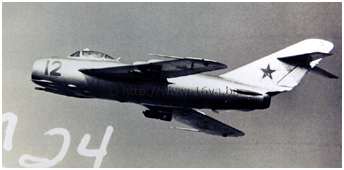
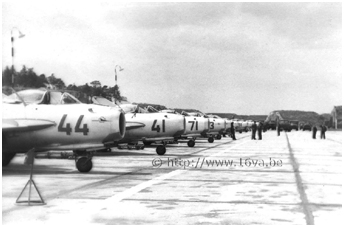 As we saw in the last part of the previous page, fighter squadrons practiced ground attack with their new MiG-15s in the early 1950s. Nevertheless, it was not until 1957 after the disbandment of all the
"shturmovik" regiments, that the first so-called fighter-bomber units were set up.
It was indeed nearly a year after the abolition of assault aviation, that a directive from the Chief of the General Staff of the Armed Forces of the USSR dated May 17, 1957 endorsed the creation of
fighter-bomber aviation.
However, such units did not enter the order of battle of the 24.VA in the GDR before 1960.
Moreover, fighter units already on strength with the 24.VA were transformed into fighter-bomber units rather than forming new regiments. Their regimental number remained, while their designation
changed from fighter aviation regiment (Istrebitel'nyy Aviatsionnyy Polk - IAP) to fighter-bomber aviation regiment (Istrebitel'nyy-Bombardirovchnyy Aviatsionnyy Polk - IBAP).
As we saw in the last part of the previous page, fighter squadrons practiced ground attack with their new MiG-15s in the early 1950s. Nevertheless, it was not until 1957 after the disbandment of all the
"shturmovik" regiments, that the first so-called fighter-bomber units were set up.
It was indeed nearly a year after the abolition of assault aviation, that a directive from the Chief of the General Staff of the Armed Forces of the USSR dated May 17, 1957 endorsed the creation of
fighter-bomber aviation.
However, such units did not enter the order of battle of the 24.VA in the GDR before 1960.
Moreover, fighter units already on strength with the 24.VA were transformed into fighter-bomber units rather than forming new regiments. Their regimental number remained, while their designation
changed from fighter aviation regiment (Istrebitel'nyy Aviatsionnyy Polk - IAP) to fighter-bomber aviation regiment (Istrebitel'nyy-Bombardirovchnyy Aviatsionnyy Polk - IBAP).
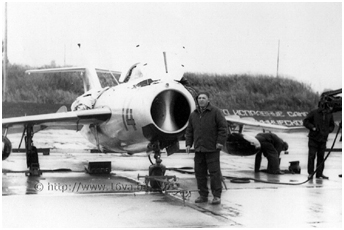
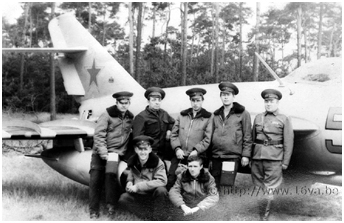 The tactical ground-attack aviation based in the GDR in 1960 comprised six regiments. They all came from the fighter community:
19.Gv, 20.Gv, 116.Gv, 497., 559., and 730.IAP. These were subordinated to two former fighter aviation divisions: 105. and 125.IAD.
Before becoming the 105.IBAD on March 1, 1960, the 105th Fighter Aviation Division (IAD) had under its control the 497., 559. and 296.IAP. In March 1960, the first two regiments became IBAP units, while the 296.IAP
joined the ranks of the 6.GvIAD; the 116.GvIAP from the 126.IAD became 116.GvIBAP on the same date and took over its place.
The 105.IAD was subordinated to the 61.GvIAK and remained under its command even after its transformation into an IBAP, until the Corps disappeared in 1980. The 61st Guards Fighter Aviation Corps (Gvardeyskyy Istrebitel'nyy
Aviatsionnyy Korpus - GvIAK) also had the 6.Gv and the 126.IAD as its subordinates.
The 125.IAD for its part was subordinated to the 71.IAK. It also remained assigned to that unit - which also controlled the 16.GvIAD - until its dissolution in 1988. Before July 1, 1960, the 125.IAD had in its ranks
the 33., 730. and 787.IAP PVO (1). The 33. and 787.IAP went to the 16.GvIAD and were replaced within the new 125.IBAP by the 19.Gv and 20.GvIAP previously on strength
with the 16.GvIAD, transformed in turn into fighter-bomber units like the 730.IAP.
The tactical ground-attack aviation based in the GDR in 1960 comprised six regiments. They all came from the fighter community:
19.Gv, 20.Gv, 116.Gv, 497., 559., and 730.IAP. These were subordinated to two former fighter aviation divisions: 105. and 125.IAD.
Before becoming the 105.IBAD on March 1, 1960, the 105th Fighter Aviation Division (IAD) had under its control the 497., 559. and 296.IAP. In March 1960, the first two regiments became IBAP units, while the 296.IAP
joined the ranks of the 6.GvIAD; the 116.GvIAP from the 126.IAD became 116.GvIBAP on the same date and took over its place.
The 105.IAD was subordinated to the 61.GvIAK and remained under its command even after its transformation into an IBAP, until the Corps disappeared in 1980. The 61st Guards Fighter Aviation Corps (Gvardeyskyy Istrebitel'nyy
Aviatsionnyy Korpus - GvIAK) also had the 6.Gv and the 126.IAD as its subordinates.
The 125.IAD for its part was subordinated to the 71.IAK. It also remained assigned to that unit - which also controlled the 16.GvIAD - until its dissolution in 1988. Before July 1, 1960, the 125.IAD had in its ranks
the 33., 730. and 787.IAP PVO (1). The 33. and 787.IAP went to the 16.GvIAD and were replaced within the new 125.IBAP by the 19.Gv and 20.GvIAP previously on strength
with the 16.GvIAD, transformed in turn into fighter-bomber units like the 730.IAP.
| ORBAT 1960 - 1976 |
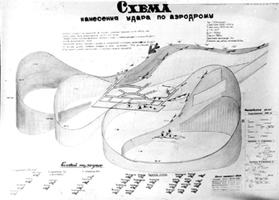
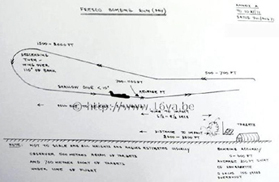 The MiG-17 began to replace the MiG-15bis in the 24.VA fighter units in early 1955. Twenty crates containing disassembled aircraft were first observed at Altes Lager on 8 March.
Although mass production of this new aircraft started at the end of 1952 in Novosibirsk and Komsomol'sk-na-Amure, it is not known if the first "Fresco" delivered
to the GDR were early MiG-17 "without suffix" or if they already were the MiG-17F.
It should be noted that some units still flew with MiG-17 "without suffix" more than ten years later (see the link entitled "The MiG descended from the sky" below).
The MiG-15bis and the MiG-17 "Fresco-A" were powered by the same 2700 kgp VK-1A engine, whereas the MiG-17F "Fresco-C" used the VK-1F engine with afterburner that increased the thrust up to 3380 kg.
The maximum speed at 3000 meters was 1145 km/h, while Mach 0.994 was reached at 11000 meters altitude.
The MiG-17 began to replace the MiG-15bis in the 24.VA fighter units in early 1955. Twenty crates containing disassembled aircraft were first observed at Altes Lager on 8 March.
Although mass production of this new aircraft started at the end of 1952 in Novosibirsk and Komsomol'sk-na-Amure, it is not known if the first "Fresco" delivered
to the GDR were early MiG-17 "without suffix" or if they already were the MiG-17F.
It should be noted that some units still flew with MiG-17 "without suffix" more than ten years later (see the link entitled "The MiG descended from the sky" below).
The MiG-15bis and the MiG-17 "Fresco-A" were powered by the same 2700 kgp VK-1A engine, whereas the MiG-17F "Fresco-C" used the VK-1F engine with afterburner that increased the thrust up to 3380 kg.
The maximum speed at 3000 meters was 1145 km/h, while Mach 0.994 was reached at 11000 meters altitude.
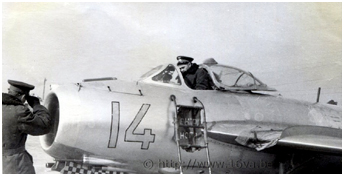
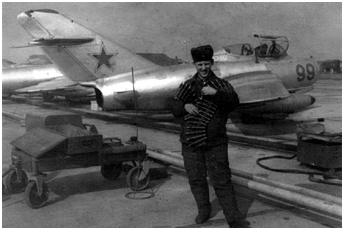 The on-board armament remained identical to that of the MiG-15bis, namely a 37mm Nudel'man N-37 cannon on the right side of the nose and two 23mm Nudel'man-Rikhter NR-23 cannons on the left side.
Two hardpoints could carry either two fuel tanks with a capacity of 400 liters or two 50, 100 or 250 kg bombs. Like on the MiG-15, the latter were attached directly
to D-4-50 or BD-5-56 bomb racks mounted inside the wings without the intermediary of a carrier pylon, as shown in the photo at the very top left of this page or below left.
Already from the early 1950s, the MiG-17s were better adapted to the fighter-bomber role. At first, they had to be able to carry large caliber unguided rockets.
To this end, MiG-17 and MiG-17F were equipped with two pylons attached to the original hardpoints where drop tanks or bombs were usually carried.
Some of these aircraft were equipped with an SRD-1M "Radal'-M" radio rangefinder which could be recognized by its long narrow fairing mounted in front of the windshield (several photos in this article show it)
and it would seem that in this case the ASP-3NM gyroscopic sight was replaced by an ASP-5N optical sight.
The on-board armament remained identical to that of the MiG-15bis, namely a 37mm Nudel'man N-37 cannon on the right side of the nose and two 23mm Nudel'man-Rikhter NR-23 cannons on the left side.
Two hardpoints could carry either two fuel tanks with a capacity of 400 liters or two 50, 100 or 250 kg bombs. Like on the MiG-15, the latter were attached directly
to D-4-50 or BD-5-56 bomb racks mounted inside the wings without the intermediary of a carrier pylon, as shown in the photo at the very top left of this page or below left.
Already from the early 1950s, the MiG-17s were better adapted to the fighter-bomber role. At first, they had to be able to carry large caliber unguided rockets.
To this end, MiG-17 and MiG-17F were equipped with two pylons attached to the original hardpoints where drop tanks or bombs were usually carried.
Some of these aircraft were equipped with an SRD-1M "Radal'-M" radio rangefinder which could be recognized by its long narrow fairing mounted in front of the windshield (several photos in this article show it)
and it would seem that in this case the ASP-3NM gyroscopic sight was replaced by an ASP-5N optical sight.
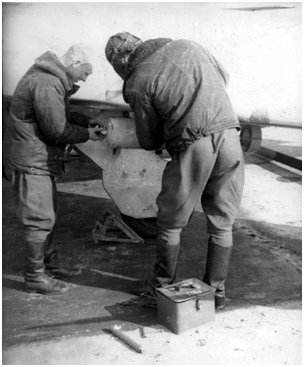 Chargement d'une bombe de 50kg sous l'aile d'un MiG-17 à Neuruppin. © B.Orlov
Chargement d'une bombe de 50kg sous l'aile d'un MiG-17 à Neuruppin. © B.Orlov
Loading a 50kg bomb under the wing of a MiG-17 at Neuruppin. © B.Orlov
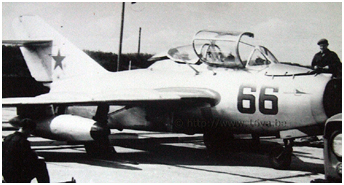 The armament included 210mm S-21 rockets mounted on PU-21 adapters. The "Fresco" modified with the AS-21
weapons system were designated MiG-17AS (> Link).
A MiG-17 with two pylons mounted at the standard hardpoints is illustrated in the page entitled "The MiG descended the sky" provided in the link further below.
Some MiG-17s received two additional pylons either outside the original hardpoints located near the landing gear (between the latter and the second wing fence - see the picture bottom right),
or between the wing root and the landing gear (just before the first wing fence).
This last configuration, for example, concerned the ground attack version of the MiG-17F produced in Poland under the designation Lim-6bis.
Forty former Lim-5 fighters (MiG-17Fs built under license in Poland by WSK Mielec) from the LSK/LV were converted to these standards in Dresden.
MARS-2 rocket pods were attached to these additional pylons (> Link).
There also was a Soviet version with pylons extending in front of the first wing fence intended to receive an ORO-190 rocket launcher tube or ARS-212 rockets
(> Link 1 / > Link 2).
Also note a version with two additional pylons BD3-60-21UM mounted in the extension of the third wing fence for S-24 rockets attached to PU-12-40UD racks
(> Link).
The armament included 210mm S-21 rockets mounted on PU-21 adapters. The "Fresco" modified with the AS-21
weapons system were designated MiG-17AS (> Link).
A MiG-17 with two pylons mounted at the standard hardpoints is illustrated in the page entitled "The MiG descended the sky" provided in the link further below.
Some MiG-17s received two additional pylons either outside the original hardpoints located near the landing gear (between the latter and the second wing fence - see the picture bottom right),
or between the wing root and the landing gear (just before the first wing fence).
This last configuration, for example, concerned the ground attack version of the MiG-17F produced in Poland under the designation Lim-6bis.
Forty former Lim-5 fighters (MiG-17Fs built under license in Poland by WSK Mielec) from the LSK/LV were converted to these standards in Dresden.
MARS-2 rocket pods were attached to these additional pylons (> Link).
There also was a Soviet version with pylons extending in front of the first wing fence intended to receive an ORO-190 rocket launcher tube or ARS-212 rockets
(> Link 1 / > Link 2).
Also note a version with two additional pylons BD3-60-21UM mounted in the extension of the third wing fence for S-24 rockets attached to PU-12-40UD racks
(> Link).
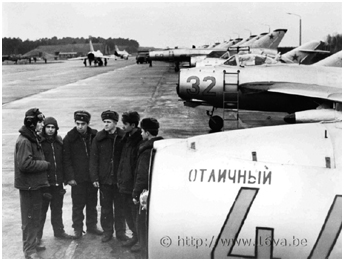
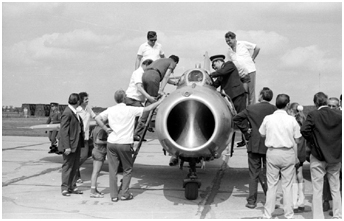 As shown in the photo on the right, the 24.VA had some "Fresco" equipped with four hardpoints. A pylon was permanently fixed to an additional hardpoint located outside the original one, approximately at the level
of the third wing fence.
Such an aircraft was, for example, observed by USMLM teams at Gross Dölln in 1972. The local regiment, like others, indeed seems to have kept a squadron armed with MiG-17F despite the conversion of other squadrons to Su-7B.
Other armament configurations including more hardpoints had existed within the Warsaw Pact or brother countries. The MiG-17F was therefore the workhorse of all fighter-bomber regiments
of the 24.VA in 1960. The training and support flights were of course provided by UTI MiG-15, since a two-seater version of the "Fresco" did not exist.
The two-seater "Midget" was powered by a 2270 kgp RD-45F engine like the MiG-15 "without suffix." It remained in service for a very a long time in fighter and fighter-bomber units after the various
MiG-17 versions were retired.
Finally, it should be mentioned that some fighter units with a mixed inventory of MiG-17F and PF "Fresco-D" - these being equipped with an RP-1 or RP-5 Izumrud (Emerald) fire tracking radar -
would have retained the latter when converting to ground attack.
As shown in the photo on the right, the 24.VA had some "Fresco" equipped with four hardpoints. A pylon was permanently fixed to an additional hardpoint located outside the original one, approximately at the level
of the third wing fence.
Such an aircraft was, for example, observed by USMLM teams at Gross Dölln in 1972. The local regiment, like others, indeed seems to have kept a squadron armed with MiG-17F despite the conversion of other squadrons to Su-7B.
Other armament configurations including more hardpoints had existed within the Warsaw Pact or brother countries. The MiG-17F was therefore the workhorse of all fighter-bomber regiments
of the 24.VA in 1960. The training and support flights were of course provided by UTI MiG-15, since a two-seater version of the "Fresco" did not exist.
The two-seater "Midget" was powered by a 2270 kgp RD-45F engine like the MiG-15 "without suffix." It remained in service for a very a long time in fighter and fighter-bomber units after the various
MiG-17 versions were retired.
Finally, it should be mentioned that some fighter units with a mixed inventory of MiG-17F and PF "Fresco-D" - these being equipped with an RP-1 or RP-5 Izumrud (Emerald) fire tracking radar -
would have retained the latter when converting to ground attack.
| The MiG descended from the sky |
From the supersonic to the nuclear era
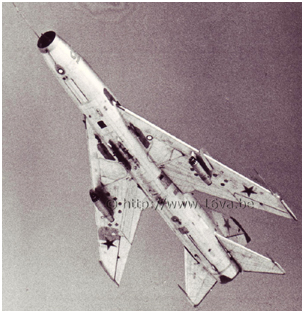
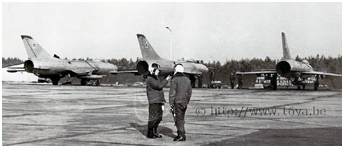 Five of the six 24.VA fighter-bomber regiments (19.Gv, 20.Gv, 116.Gv, 497. and 559.IBAP) replaced their MiG-17F with Sukhoy Su-7B "Fitter-A" for most of them in the early sixties.
The 730.IBAP at Neuruppin with the MiG-21 - from 1975 only - was an exception.
The 19.GvIBAP began its re-equipment in the second half of 1962, a few months after its move from Wittstock to Lärz. According to the 24.VA order of battle established by the USMLM in 1964,
the regiment that year fielded 36 "Fitter", 8 "Midget" and 2 "Fresco-C." The 20.GvIBAP then based at Parchim converted its inventory in 1963 (12 "Fitter" / 24 "Fresco" / as well as 11 "Beagle"
and 1 "Cab" on strength with the 74.OBAE in 1964).
The 497.IBAP at Grossenhain and the 559.IBAP at Finsterwalde received Su-7B in 1964 (respectively 36 and 42 "Fitter" according to USMLM observations). Finally, the 116.GvIBAP then based at Brand
gradually began to abandon its MiG-17F in 1974. The regiment gradually received aircraft from the regiments at Finsterwalde
(conversion to the MiG-27 in 1976), Grossenhain (Su-17M2 in 1976) and Lärz (MiG-27 in 1977) since the Su-7 production had ceased in 1972. One squadron, however, would have kept its MiG-17F.
Five of the six 24.VA fighter-bomber regiments (19.Gv, 20.Gv, 116.Gv, 497. and 559.IBAP) replaced their MiG-17F with Sukhoy Su-7B "Fitter-A" for most of them in the early sixties.
The 730.IBAP at Neuruppin with the MiG-21 - from 1975 only - was an exception.
The 19.GvIBAP began its re-equipment in the second half of 1962, a few months after its move from Wittstock to Lärz. According to the 24.VA order of battle established by the USMLM in 1964,
the regiment that year fielded 36 "Fitter", 8 "Midget" and 2 "Fresco-C." The 20.GvIBAP then based at Parchim converted its inventory in 1963 (12 "Fitter" / 24 "Fresco" / as well as 11 "Beagle"
and 1 "Cab" on strength with the 74.OBAE in 1964).
The 497.IBAP at Grossenhain and the 559.IBAP at Finsterwalde received Su-7B in 1964 (respectively 36 and 42 "Fitter" according to USMLM observations). Finally, the 116.GvIBAP then based at Brand
gradually began to abandon its MiG-17F in 1974. The regiment gradually received aircraft from the regiments at Finsterwalde
(conversion to the MiG-27 in 1976), Grossenhain (Su-17M2 in 1976) and Lärz (MiG-27 in 1977) since the Su-7 production had ceased in 1972. One squadron, however, would have kept its MiG-17F.
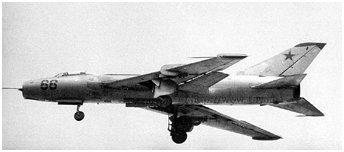
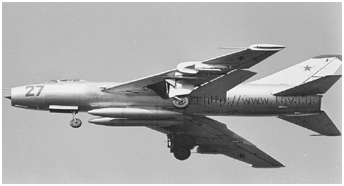 The Su-7B was the first Soviet supersonic fighter-bomber. While carrying tactical nuclear bombs was not on the agenda during its development,
the Su-7B was not long in being adapted to this new mission which would involve a new doctrine of employment for the Soviet Frontal Aviation.
The Su-7B was an evolution of the Su-7 fighter whose prototype designated S-1 (S-2 for the series production) made its first flight on September 7, 1955.
This aircraft introduced several innovations to Soviet aircraft such as an all-moving horizontal stabilizer and a reactor variable-geometry air intake for supersonic flight.
Only two air defense regiments based in the Far East were equipped with it from 1959 until 1965.
The MiG-15bis and MiG-17/F that replaced the Il-10 in ground attack missions were only a half measure. Their weapon load was very limited as was their ability to deliver it accurately.
Frontal Aviation needed an aircraft specialized for this mission. The S-22 (the Sukhoy OKB internal designation of the Su-7B) was developed based on the Su-7 airframe from 1957;
a government decree formalized it on July 31, 1958. This choice was dictated by the potential of the Su-7 (1250 km/h at sea level and Mach 2.1 at 11,000 meters, potential payload capacity of 2000 kg), and the
uncertainty as to the development of other aircraft - it was the time of the "all missile" illusion.
The first flight of the prototype S22-1 fighter-bomber took place on April 24, 1959. Compared to the Su-7 fighter, the new aircraft had another PUS6-2 weapon system adapted to its new range of weapons.
BD3-57 pylons were added to carry them, and the fuel capacity was increased.
The Su-7B was the first Soviet supersonic fighter-bomber. While carrying tactical nuclear bombs was not on the agenda during its development,
the Su-7B was not long in being adapted to this new mission which would involve a new doctrine of employment for the Soviet Frontal Aviation.
The Su-7B was an evolution of the Su-7 fighter whose prototype designated S-1 (S-2 for the series production) made its first flight on September 7, 1955.
This aircraft introduced several innovations to Soviet aircraft such as an all-moving horizontal stabilizer and a reactor variable-geometry air intake for supersonic flight.
Only two air defense regiments based in the Far East were equipped with it from 1959 until 1965.
The MiG-15bis and MiG-17/F that replaced the Il-10 in ground attack missions were only a half measure. Their weapon load was very limited as was their ability to deliver it accurately.
Frontal Aviation needed an aircraft specialized for this mission. The S-22 (the Sukhoy OKB internal designation of the Su-7B) was developed based on the Su-7 airframe from 1957;
a government decree formalized it on July 31, 1958. This choice was dictated by the potential of the Su-7 (1250 km/h at sea level and Mach 2.1 at 11,000 meters, potential payload capacity of 2000 kg), and the
uncertainty as to the development of other aircraft - it was the time of the "all missile" illusion.
The first flight of the prototype S22-1 fighter-bomber took place on April 24, 1959. Compared to the Su-7 fighter, the new aircraft had another PUS6-2 weapon system adapted to its new range of weapons.
BD3-57 pylons were added to carry them, and the fuel capacity was increased.
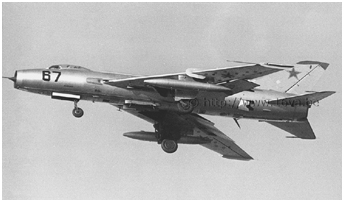
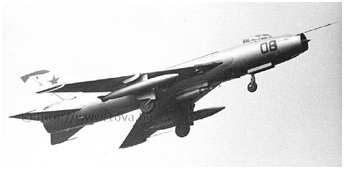 In addition, the mounting of a Lyul'ka AL-7F-1 reactor more powerful with the afterburner on (6800 kgp dry and 9200 kgp with afterburner)
than the original AL-7F had led to a modification of the rear fuselage. Improvements in the air intakes of the latter had also affected the nose of the aircraft. Serial production of the Su-7B was launched at plant No.126
in Komsomol'sk-na-Amure as early as 1960 and it ended in 1962 after 431 aircraft had been manufactured.
Like the Su-7 fighter, the Su-7B and all its subsequent versions (Su-7BM, -BMK (2) and -BKL) were armed with two 30mm Nudel'man-Rikhter NR-30 cannons
associated with the SRD-5 rangefinder, mounted at the wing root.
The weapon load included bombs up to 500kg with a maximum load of two tons, S-5 57mm unguided rockets fired from four ORO-57K pods (8 projectiles each) and later UB-16-57U pods (16 projectiles each),
up to 28 160mm S-3K rockets attached to APU-14U multiple rocket launcher racks, two or four 210mm S-21 rockets, and two or four 240mm S-24 rockets. Since firing rockets often caused the reactor to shut down, a system
designated KS-1 automatically reduced the engine speed when they were fired and restored it immediately afterwards. Four hardpoints were available: two BD3-57KR pylons under the wings fixed between the landing gear
and the wing fence and two BD3-57FR pylons under the fuselage. Only the ventral hardpoints could carry two PTB-640 fuel tanks.
In addition, the mounting of a Lyul'ka AL-7F-1 reactor more powerful with the afterburner on (6800 kgp dry and 9200 kgp with afterburner)
than the original AL-7F had led to a modification of the rear fuselage. Improvements in the air intakes of the latter had also affected the nose of the aircraft. Serial production of the Su-7B was launched at plant No.126
in Komsomol'sk-na-Amure as early as 1960 and it ended in 1962 after 431 aircraft had been manufactured.
Like the Su-7 fighter, the Su-7B and all its subsequent versions (Su-7BM, -BMK (2) and -BKL) were armed with two 30mm Nudel'man-Rikhter NR-30 cannons
associated with the SRD-5 rangefinder, mounted at the wing root.
The weapon load included bombs up to 500kg with a maximum load of two tons, S-5 57mm unguided rockets fired from four ORO-57K pods (8 projectiles each) and later UB-16-57U pods (16 projectiles each),
up to 28 160mm S-3K rockets attached to APU-14U multiple rocket launcher racks, two or four 210mm S-21 rockets, and two or four 240mm S-24 rockets. Since firing rockets often caused the reactor to shut down, a system
designated KS-1 automatically reduced the engine speed when they were fired and restored it immediately afterwards. Four hardpoints were available: two BD3-57KR pylons under the wings fixed between the landing gear
and the wing fence and two BD3-57FR pylons under the fuselage. Only the ventral hardpoints could carry two PTB-640 fuel tanks.
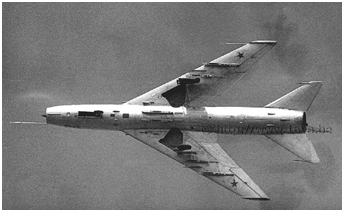
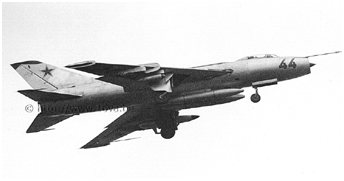 Aircraft built from 1970 on were wired to carry an SPS-141 or 142 Siren-F (Lilac) electronic countermeasures pod. This modification was later extended to earlier aircraft.
The "Siren" pod (versions 141 and 142 differed in their operating frequency range) was connected to its own pylon under the left wing. A UB-16-57 rocket pod with weight equivalent to that of the SPS was attached under the
right wing to restore balance. The ECM pod that reduced the handling characteristics of the Su-7 could not be dropped in flight and consequently, the rocket launcher pod had to remain in place as well.
The SPS-141/142 were intended to jam the guidance systems of anti-aircraft artillery, air-to-ground missiles, and air-to-air missiles in the forward sector.
The receiver antenna was located behind the forward radome with the emitter antenna mounted on the end of what looked like a hockey stick at the rear left.
"Lilac" worked in the "Transmit" or "Receive" modes set by the pilot on the station control panel in the cockpit. In the first mode, the "Lilac" operating principle was to receive signals from radar systems that irradiate
the aircraft, analyze them, and then re-emit the received signals with additional interference modulation. In the second mode, the SPS only received and analyzed signals, notifying the pilot about the
exposure of his aircraft to enemy radar.
Aircraft built from 1970 on were wired to carry an SPS-141 or 142 Siren-F (Lilac) electronic countermeasures pod. This modification was later extended to earlier aircraft.
The "Siren" pod (versions 141 and 142 differed in their operating frequency range) was connected to its own pylon under the left wing. A UB-16-57 rocket pod with weight equivalent to that of the SPS was attached under the
right wing to restore balance. The ECM pod that reduced the handling characteristics of the Su-7 could not be dropped in flight and consequently, the rocket launcher pod had to remain in place as well.
The SPS-141/142 were intended to jam the guidance systems of anti-aircraft artillery, air-to-ground missiles, and air-to-air missiles in the forward sector.
The receiver antenna was located behind the forward radome with the emitter antenna mounted on the end of what looked like a hockey stick at the rear left.
"Lilac" worked in the "Transmit" or "Receive" modes set by the pilot on the station control panel in the cockpit. In the first mode, the "Lilac" operating principle was to receive signals from radar systems that irradiate
the aircraft, analyze them, and then re-emit the received signals with additional interference modulation. In the second mode, the SPS only received and analyzed signals, notifying the pilot about the
exposure of his aircraft to enemy radar.
The RN-24 nuclear bomb weighing 500kg (> Link) (3) and the RN-28 of 275kg with an
adjustable power (> Link) were part of the "Fitter" weapon package, although
the aircraft of the first production batches were not nuclear-capable. These special weapons required a specific configuration.
A single nuclear bomb could be carried, and it was always located under the belly of the aircraft on the left side, attached to a dedicated BD3-56FN pylon. Alternatively, an IAB-500 practice bomb similar in shape to
the RN-24 was likely to take its place. The nuclear bombs were dropped according to the LABS (toss-bombing) technique, i.e. a drop during a resource. For more information on this procedure, the PBK-1 bombing sight used
with the Su-7B, and the use of tactical nuclear weapons in general, consult in detail the following links:
- Special Weapons
- LABS at Gadow-Rossow
- Seen from the East: Hawk strike
- Seen from the West: Hawk Strike: analysis
| The Sukhoi fallen from the sky |
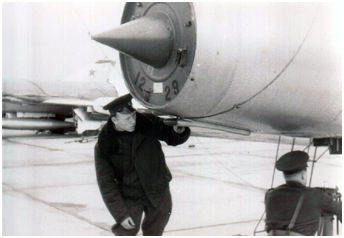
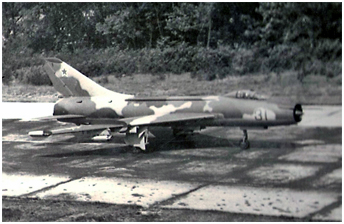 During the early 1970s, some aircraft received two additional hardpoints fixed under the wings outside the wing fence (such aircraft were observed in the GDR from 1972) bringing the maximum external load to 2500 kg.
They could carry UB-32-57 rocket pods (too bulky for the inside hardpoints), S-21 or S-24 rockets, and bombs. It was also during that time frame that camouflaged aircraft appeared in the ranks of the 24.VA (1973).
In 1960, work was began to increase the autonomy of the Su-7B, giving rise to the Su-7BM (S-22M) version that entered service around 1962. The fuel capacity was increased from 3415 to 3650 liters, while the wing hardpoints
were adapted to carry ferry tanks. In addition to two long fairings located on either side of the fuselage spine (nevertheless likely to be mounted on the Su-7B from production batch n°31 in order to ease
maintenance operations by channelling the bundles of electrical wires), the Su-7BM could be identified by the external fairing running from the nose to the trailing edge
of the wing under the left side of the fuselage. It was a component of the anti-FOD device. Air blown by the last stage of the reactor's compressor was deflected via this duct to the bottom of the nose air intake,
thus blowing away any foreign bodies. The pitot tube previously located above the nose in the center was moved to the right. However, this modification already had been observed on some Su-7Bs. The reactor was more reliable
since its potential had been increased. The external armament remained unchanged, fixed under four pylons. As in the case of the Su-7B, two additional pylons were also added under the outer wing panels.
In all, 290 Su-7BM had been produced when production ceased in 1965.
During the early 1970s, some aircraft received two additional hardpoints fixed under the wings outside the wing fence (such aircraft were observed in the GDR from 1972) bringing the maximum external load to 2500 kg.
They could carry UB-32-57 rocket pods (too bulky for the inside hardpoints), S-21 or S-24 rockets, and bombs. It was also during that time frame that camouflaged aircraft appeared in the ranks of the 24.VA (1973).
In 1960, work was began to increase the autonomy of the Su-7B, giving rise to the Su-7BM (S-22M) version that entered service around 1962. The fuel capacity was increased from 3415 to 3650 liters, while the wing hardpoints
were adapted to carry ferry tanks. In addition to two long fairings located on either side of the fuselage spine (nevertheless likely to be mounted on the Su-7B from production batch n°31 in order to ease
maintenance operations by channelling the bundles of electrical wires), the Su-7BM could be identified by the external fairing running from the nose to the trailing edge
of the wing under the left side of the fuselage. It was a component of the anti-FOD device. Air blown by the last stage of the reactor's compressor was deflected via this duct to the bottom of the nose air intake,
thus blowing away any foreign bodies. The pitot tube previously located above the nose in the center was moved to the right. However, this modification already had been observed on some Su-7Bs. The reactor was more reliable
since its potential had been increased. The external armament remained unchanged, fixed under four pylons. As in the case of the Su-7B, two additional pylons were also added under the outer wing panels.
In all, 290 Su-7BM had been produced when production ceased in 1965.
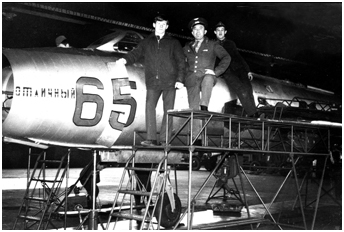
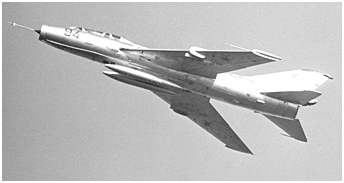 Whereas the Su-7B and BM were able to operate from semi-prepared fields, the Sukhoi OKB-51 had pushed further experiments in this area by testing mixed main landing gear composed of both traditional wheels and a small
ski mounted in parallel to absorb the irregularities of the terrain, or even a landing gear composed solely of skis. Thus was born the Su-7BKL (S-22KL kolesnyy-lyzhnyy or wheel-ski) that replaced the Su-7BM on
the production lines in 1965. This new
version therefore had a wheel/ski main undercarriage. The ski could remain slightly raised or lowered as needed. The vestige of such a landing gear (without its wheel)
(4) was still visible in the Finsterwalde scrapyard in the early 1990s (> Link).
In addition, two SPRD-110 (> Link) booster rockets with a three tons thrust each, could be attached under the rear fuselage to aid take-off.
The Su-7BKL also could be identified by the brake chute housing - previously hidden behind a hatch under the fuselage -
located at the base of the fin and protruding under the rudder. However, this version essentially identical to the Su-7BM could carry PTB-950 drop tanks of greater capacity.
The "Fitter" regiments, of course, used Su-7U "Moujik" two-seaters for training purposes.
Nevertheless, most of the units had retained UTI MiG-15 "Midget" to perform both training and service flights. For example, one should also note that the 116.GvIBAP had a handful of Aero L-29 "Maya" in its inventory for the same
reasons (> Link) - although they were received late in 1978. The production of a two-seater version of the Sukhoy fighter-bomber had indeed been slow to materialize, the first production aircraft only taking
off in April 1966! They consequently benefited from the improvements of the BM and BKL versions with the anti-FOD device or the relocation of the braking chute. The two-seaters had kept the guns of the single-seater but
had a carrying capacity of 500 kg of bombs. In addition, they had a PBK-2 sight like the Su-7BMs. The "Moujik" could also use the full panoply of unguided rockets, but in half the quantity of the single-seat version.
Finally, it was possible to carry four PTB-640 or -950 drop tanks under the belly and the wings.
Whereas the Su-7B and BM were able to operate from semi-prepared fields, the Sukhoi OKB-51 had pushed further experiments in this area by testing mixed main landing gear composed of both traditional wheels and a small
ski mounted in parallel to absorb the irregularities of the terrain, or even a landing gear composed solely of skis. Thus was born the Su-7BKL (S-22KL kolesnyy-lyzhnyy or wheel-ski) that replaced the Su-7BM on
the production lines in 1965. This new
version therefore had a wheel/ski main undercarriage. The ski could remain slightly raised or lowered as needed. The vestige of such a landing gear (without its wheel)
(4) was still visible in the Finsterwalde scrapyard in the early 1990s (> Link).
In addition, two SPRD-110 (> Link) booster rockets with a three tons thrust each, could be attached under the rear fuselage to aid take-off.
The Su-7BKL also could be identified by the brake chute housing - previously hidden behind a hatch under the fuselage -
located at the base of the fin and protruding under the rudder. However, this version essentially identical to the Su-7BM could carry PTB-950 drop tanks of greater capacity.
The "Fitter" regiments, of course, used Su-7U "Moujik" two-seaters for training purposes.
Nevertheless, most of the units had retained UTI MiG-15 "Midget" to perform both training and service flights. For example, one should also note that the 116.GvIBAP had a handful of Aero L-29 "Maya" in its inventory for the same
reasons (> Link) - although they were received late in 1978. The production of a two-seater version of the Sukhoy fighter-bomber had indeed been slow to materialize, the first production aircraft only taking
off in April 1966! They consequently benefited from the improvements of the BM and BKL versions with the anti-FOD device or the relocation of the braking chute. The two-seaters had kept the guns of the single-seater but
had a carrying capacity of 500 kg of bombs. In addition, they had a PBK-2 sight like the Su-7BMs. The "Moujik" could also use the full panoply of unguided rockets, but in half the quantity of the single-seat version.
Finally, it was possible to carry four PTB-640 or -950 drop tanks under the belly and the wings.
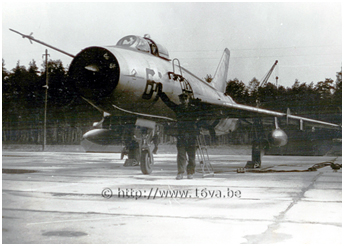
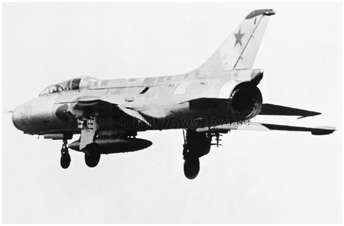 Although the different versions of the "Fitter" undoubtedly constituted significant progress compared to its predecessors, they were not devoid of flaws such as hard and inhomogeneous flight controls, required heavy
maintenance, or even had a loss rate comparable to that of the German F-104s... The Russian authors of a work devoted to the Su-7B (5) quote Air Marshal Konstantin A.
Vershinin, VVS Commander-in-Chief , describing in 1966 the Yak-28 and Su-7B attack planes: "They have limited ability for detection and aimed destruction of targets, insufficient range, and a long take-off and landing roll
[the takeoff of the Su-7B occurred approximately 360-380 km/h as opposed to 220-230 km/h for the MiG-17]. Based upon their flight data and equipment, these aircraft are inferior to the American F-105D and F-4C, which
are all-weather..."
Although the different versions of the "Fitter" undoubtedly constituted significant progress compared to its predecessors, they were not devoid of flaws such as hard and inhomogeneous flight controls, required heavy
maintenance, or even had a loss rate comparable to that of the German F-104s... The Russian authors of a work devoted to the Su-7B (5) quote Air Marshal Konstantin A.
Vershinin, VVS Commander-in-Chief , describing in 1966 the Yak-28 and Su-7B attack planes: "They have limited ability for detection and aimed destruction of targets, insufficient range, and a long take-off and landing roll
[the takeoff of the Su-7B occurred approximately 360-380 km/h as opposed to 220-230 km/h for the MiG-17]. Based upon their flight data and equipment, these aircraft are inferior to the American F-105D and F-4C, which
are all-weather..."
notes
(1) The mention "PVO" for Protivovozdushnaya Oborona or Air Defense is a legacy of the past, when the regiments were activated in the late 1920s
for the 33.IAP and at the beginning of the war for the
730. and 787.IAP, as Fighter Aviation Air Defense Regiments (IAP PVO).
(2)
The Su-7BMK was the export version with an anti-FOD device, four under-wing hardpoints, and a brake chute located under the fin.
It was the most numerous variant with 441 aircraft built. Some aircraft whose deliveries were cancelled were added to the inventaries of VVS
front line units and received the necessary modifications to enable them to carry a nuclear bomb.
(3)
RN-24 or "Article 244" not to be confused with the 28-42 kt RDS-4 "Tatyana" bomb from 1953 with the same article number (> Link).
The RN-24 was the first Soviet nuclear bomb to be mass-produced.
(4)
A few Su-7BM were fitted with a similar undercarriage. To date, there is no known photo of Su-7BKL based in the GDR.
It should also be noted that a wheel/ski undercarriage was tested on the MiG-21 with good results, but the experiment was not followed up.
(5)
"The first supersonic fighter-bomber - The Su-7B emerges from the shadows" by Viktor Markovskiy and Igor' Prikhodchenko
(in Russian language).
 |
Plan du site - Sitemap |  |
